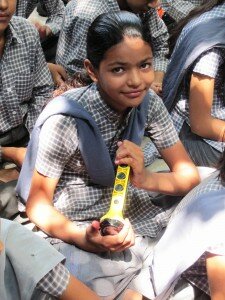Out of the Darkness and into the Future with Solar Technology
DC Area High School student, Karishma Popli, examines “the problems in our society, and the little things I can do to help” during a light distribution with One Million Lights

Karishma Popoli, Junior at Thomas Jefferson High School for Science and Technology in Alexandria, Virginia, poses after the successful distribution of solar lights at Haveli School in India
I am a 16-year-old junior at Thomas Jefferson High School for Science and Technology (TJ) in Alexandria, Virginia. I started this project last year, when I was awarded a grant from my high school based on a school-wide competition to address the question, “What are the Social Responsibilities of Educated People?” I believe it is the social responsibility of educated people to help educate those less fortunate and confined by rural impediments.
My grant proposal was to provide solar lamps to underprivileged students at a rural village school in the desert of Rajasthan, India, so they can effectively study at night. I spent a lot of time researching the simple science of photovoltaics and interviewed CEO’s of several solar lamp companies which help provide lamps to rural villages. I even tried contacting U.S. Energy Secretary Chu’s Office about my project since he announced at the Copenhagen Climate Conference on Dec.14, 2009 that the U.S. would help fund solar lamp distribution to developing nations. I was glad to meet and have the opportunity to work with Ms. Anna Sidana and the whole One Million Lights team. Everyone at One Million Lights was very supportive of my initiative and agreed to double the amount of lights I was able to secure with the grant money from my school, and helped me plan every step of the way. I could not have accomplished any of this without them.

One of the excited solar light recipients at Haveli School
I am a fourth generation American of Indian descent. My great-grandfather converted his ancestral home (haveli) into a school for underprivileged students in grades K-12 prior to emigrating permanently to the U.S. When I visited India for the first time in 2006, I was shocked at how difficult it was to study or read at night due to lack of consistent electricity. Alternative energy sources, such as solar lamps would make a tremendous quality of life improvement for the students of the Haveli School, as they learn how to harness energy from the sun. This is a practical, low-cost, and efficient way to bring rural school children out of the darkness and into the future with solar technology!
The whole process that went into planning and setting up the project was worth the final result. Seeing all 350 students, gathered in the school courtyard, eager to receive a solar lamp as well as learn about the benefits of solar technology is something I will never forget. It was amazing to see how students there learned similar subjects as us, except they do not have the technology we have today.
Karishma and her mother, Nita Popli, interview students at Haveli School
It was an incredible, life-changing experience visiting the village school to distribute the solar lamps. Not only did I become more socially aware of the problems in our society, and the little things I can do to help, but it was a self-learning process as well. As a fourth generation American of Indian descent, I was able to learn more about my culture and heritage while researching and experiencing this trip. I believe it is important to learn about new cultures and experience new places while helping underprivileged students gain access to technology necessary to further their education.

